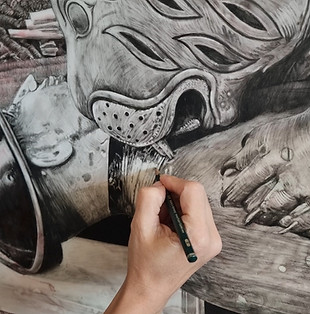Hundred Years a Jackal
Repatriation of Tipu's Tiger

Repatriation of Tipu’s Tiger. Graphite, water soluable graphite, Suminagashi ink on mylar. 122 cm x 152 cm. 2022
How many hands must a stolen object change before its provenance is cleansed? Must all objects be preserved? Especially those incarcerated in spaces of colonial pride as trophies harking back to an unmistakable violent past. Repatriation of Tipu’s Tiger is the return of one of the most prized possessions of the Victoria & Albert Museum, stolen from Srirangapatna after the British defeated and killed Tipu Sultan in his own island capital of Mysore.

'Tipu's Tiger', 1780s or 1790s, Mysore, India. Museum no 2545 (IS). © Victoria and Albert Museum, London


Image: Birds of Passage, Nancy K Sheilds
Mapping monuments, forts, ghats, botanical gardens, tombs, temples, and palaces, Qizilbash follows the route Henrietta Clive took a year after the storming of Srirangapatna. Qizilbash begins her journey from Fort St. George in Chennai, stopping in Arcot, visiting the hostage princes in Vellore, peeping into the summer palace in Bangalore as Lady Clive showers in Tipu’s state-of-the-art bathroom, and finally arriving in Srirangapatna to rightfully return Tipu’s Tiger to Daulat Bagh Palace.
Press Release on other Tipu Sultan belongings from the Official UK government website dated November 12, 2021


Will it be received warmly? Has its incarceration of 223 years contorted its current relevance and context? Will it be preserved as immaculately as it was in a Western museum? But must all historical objects be preserved at all costs?

